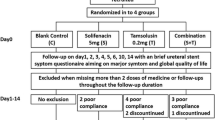Abstract
Purpose
We aimed to assess the efficacy and safety of Mirabegron vs. solifenacin to treat LUTS resulting from DJ-stent insertion.
Methods
A total of 97 patients who had DJ-stent inserted for urinary stone disease were randomly divided into three groups according to received treatment. Group A took Mirabegron 50 mg daily, group B took solifenacin 5 mg daily from the 4th day after stent placement until the stent was removed, and group C only was hydrated well. All patients were evaluated by USSQ and IPSS at 4th day post-insertion of ureteral stent, follow-up day before removing of stent and post-removal of stent.
Results
The USSQ urinary symptom scores at day 4 comparing to day of removal of stent showed significant difference in between study groups (32 ± 6–13 ± 6 vs. 31 ± 6–14 ± 4 in Mirabegron and solifenacin, respectively) and without significant difference in control group. The USSQ body pain score significantly decreased in both Mirabegron and solifenacin groups at day of stent removal comparing to day 4 post-insertion of DJ with insignificant decreasing in the control group. Quality of life scores showed significant improving in Mirabegron and solifenacin group, and there was no difference in control group at 4 and 14 days after treatment. No severe complications were observed in either group.
Discussion/Conclusion
In our series, we indicate that Mirabegron and solifenacin can be used to improve symptoms caused by the insertion of DJ-stent without significant difference.

Similar content being viewed by others
References
Chew BH, Knudsen BE, Denstedt JD (2004) The use of stents in contemporary urology. Curr Opin Urol 14(2):111–115
Joshi HB, Stainthorpe A, MacDonagh RP, Keeley FX Jr, Timoney AG, Barry MJ (2003) Indwelling ureteral stents: evaluation of symptoms, quality of life and utility. J Urol 169:1065–1069
Damiano R, Autorino R, De Sio M, Cantiello F, Quarto G, Perdona S et al (2005) Does the ureteral stents impact urinary symptoms and quality of life? A prospective randomized study. J Eur Urol 48:673–678
Lim SJ, Sul KC, Song HK, Na GY, Shin HJ, Oh HT et al (2010) Chages in urinary symptoms and tolerance due to long-term ureteral double-J stenting. Int Neuroural J 14:93–99
Leibovici D, Cooper A, Lindner A, Otrowsky R, Kleinmann J, Velikanov S et al (2005) Ureteral stents: Morbidity and impact on quality of life. Isr Med Assoc J 7:491–494
Hughes B, Wiseman OJ, Thompson T, Masood J, Daron RS, Mcllhenny C et al (2014) The dilemma of post-ureteroscopy stenting. BJU Int 113:184–185
Joshi HB, Newns N, Stainthorpe A, MacDonagh RP, Keeley AG, Timoney AG (2003) Ureteral stent symptom questionnaire. Development and validation of a multidimensional quality of life measure. J Urol 169:1060–1064
El-Nahas AR, Tharwat M, Elsaadany M, Mosbah A, Metwally MA, Hawary A et al (2014) Validation of the Arabic linguistic version of the ureteral stent symptoms questionnaire. Arab J Urol 12:290–293
Kuyumcuoglu U, Eryildirim B, Tuncer M, Faydaci G, Tarhan F, Ozgul A (2012) Effectiveness of medical treatment in overcoming the ureteral double-J stent related symptoms. Can Urol Assoc J 6:234–237
Pricop C, Ciuta C, Mischianu D, Rusu F (2009) Is there a role for tamsulosin or solifenacine in the management of urinary tract symptoms in patients with double-J stent? J Urol 74:S25
Zhou L, Cai X, Li H, Wang KJ (2015) Effects of α-blockers, antimuscarinics, or combination therapy in relieving ureteral stent-related symptoms: a meta-analysis. J Endourol 29(6):650–656
Aytac S, Caglar Y, Ozgur H, Ahmet U (2020) Treatment of ureteral catheter related symptoms; mirabegron versus tamsulosin/solifenacin combination: a randomized controlled trial. Arch Esp Urol 73(1):54–59
Kelleher C, Hakimi Z, Zur R, Siddiqui E, Maman K, Aballéa S et al (2018) Efficacy and tolerability of mirabegron compared with antimuscarinic monotherapy or combination therapies for overactive bladder: a systematic review and network meta-analysis. Eur Urol 74(3):324–333
Tae BS, Cho S, Jeon BJ, Choi H, Park JY, Cho SY et al (2018) Does mirabegron relieve ureteric stent-related discomfort? A prospective, randomized, multicentre study. BJU Int 122(5):866–872
Chapple CR, Siddiqui E (2017) Mirabegron for the treatment of overactive bladder: a review of efficacy, safety and tolerability with a focus on male, elderly and antimuscarinic poorresponder populations, and patients with OAB in Asia. Expert Rev Clin Pharmacol 10:131–151
Chen HL, Chen TC, Chang HM, Juan YS, Huang WH, Pan HF et al (2018) Mirabegron is alternative to antimuscarinic agents for overactive bladder without higher risk in hypertension: a systematic review and meta-analysis. World J Urol 36(8):1285–1297
Acknowledgements
This research was supported by Al-Jedaani group of hospitals. We thanks all participants and our colleagues who provided insight and expertise that greatly assisted the research, although they may not agree with all of the conclusion of this paper.
Funding
The authors did not receive support from any organization for the submitted work.
Author information
Authors and Affiliations
Contributions
ASA involved in protocol/project development, manuscript writing/editing, NMS took part in data collection or management, data analysis, and AMG involved in project development, manuscript writing/editing.
Corresponding author
Ethics declarations
Conflict of interest
The authors have no conflict of interests to declare that are relevant to the content of this article.
Ethics approval
The questionnaire and methodology for this study were reviewed and approved by the institutional Human Research Ethics committee of the University of Al-Jedaani group of hospitals (3 medical center in Kingdom of Saudi Arabia, city Jeddah) on January 18, 2020, under approval number (47-ISB 4312).
Informed consent
Informed consent was obtained from all individual participants included in the study.
Additional information
Publisher's Note
Springer Nature remains neutral with regard to jurisdictional claims in published maps and institutional affiliations.
Rights and permissions
About this article
Cite this article
Abdelaziz, A.S., Salama, N.M. & Ghoneem, A.M. Mirabegron vs. solifenacin in control of endoscopically inserted ureteral stent-related symptoms. World J Urol 40, 2113–2119 (2022). https://doi.org/10.1007/s00345-022-04068-2
Received:
Accepted:
Published:
Issue Date:
DOI: https://doi.org/10.1007/s00345-022-04068-2




